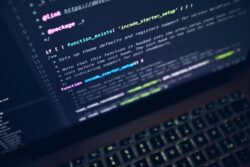Have you ever wondered if it’s possible to create your very own artificial intelligence? Well, wonder no more! In this article, we will explore the fascinating world of DIY AI and provide you with a simple guide on how to get started. Whether you’re a tech enthusiast, a hobbyist, or simply curious about the possibilities of AI, this article will walk you through the necessary steps to bring your own intelligent creation to life. So, dust off your coding skills and let’s embark on this exciting journey of making your own artificial intelligence!
Choosing the Right Framework
Artificial Intelligence (AI) frameworks are essential tools for developing AI models and applications. With numerous frameworks available, choosing the right one can be a daunting task. It is crucial to understand the different AI frameworks and compare them to select the most suitable framework based on your specific requirements.
Understanding the different AI frameworks
AI frameworks provide developers with a set of tools and libraries to build, train, and deploy AI models. These frameworks come with various features and capabilities, making them suitable for different AI applications. Some popular AI frameworks include TensorFlow, PyTorch, Keras, and Scikit-learn.
TensorFlow is a widely-used open-source framework that offers comprehensive support for deep learning and neural networks. It provides a flexible architecture and is known for its scalability and compatibility across different platforms.
PyTorch is another popular open-source framework that focuses on flexibility and ease of use. It is renowned for its dynamic computational graph and is commonly used for research purposes.
Keras is a user-friendly API that can run on top of TensorFlow or Theano. It simplifies the development of deep learning models and is ideal for beginners or those looking for rapid prototyping.
Scikit-learn is a Python library that provides a wide range of machine learning algorithms and tools. It is suitable for various applications and is known for its simplicity and efficiency.
Comparing popular AI frameworks
When choosing an AI framework, it is essential to compare their features, performance, and community support. Consider factors such as ease of use, documentation availability, compatibility with your existing infrastructure, and the flexibility to support your specific AI needs.
TensorFlow and PyTorch are both powerful frameworks used in deep learning. TensorFlow offers extensive model deployment options, while PyTorch allows for more flexibility in model construction. Keras, being built on top of TensorFlow, is a good choice for beginners or those seeking a high-level API. Scikit-learn, on the other hand, excels in traditional machine learning algorithms and is great for smaller-scale projects.
Selecting a framework based on your requirements
To choose the right framework, evaluate your project requirements and determine which framework aligns best with your goals. Consider the data you’ll be working with, the type of AI models you aim to build, and the level of expertise you or your team possess.
For complex deep learning projects with a focus on deployment and scalability, TensorFlow is a popular choice. PyTorch is ideal for research-oriented projects that require flexibility in model construction. If you’re new to AI and want a simple and intuitive framework, Keras might be the right fit. Scikit-learn is a great option for traditional machine learning projects with a smaller scale.
Ultimately, it’s important to experiment and explore different frameworks to find the one that best suits your specific needs and preferences.
Gathering and Preparing Data
Before diving into building the AI model, it is crucial to gather and prepare the necessary data. This process involves defining the problem statement, identifying the required data, collecting and cleaning the data, and creating a labeled data set.
Defining the problem statement
Clearly defining the problem statement is the first step in any AI project. It involves understanding the specific task you want your AI model to perform and setting clear objectives. Ask yourself questions like what problem you are trying to solve, what type of data you will need, and what metrics will be used to evaluate the model’s performance.
Identifying the required data
Once you have defined the problem statement, identify the type of data required to train your AI model. This could include structured data (such as numerical values in a tabular format), unstructured data (like text or images), or a combination of both. Determine if you need historical data, real-time data, or a mix of both to make accurate predictions.
Collecting and cleaning the data
After identifying the required data, the next step is to collect it from reliable sources. This could involve crawling the internet, accessing APIs, or gathering data manually. Ensure that the data collected is representative of the problem you want to solve and covers a wide range of scenarios.
Cleaning the data is crucial to remove any inconsistencies, errors, or outliers that could affect the model’s performance. This involves tasks like handling missing values, standardizing the data format, and removing irrelevant or duplicate entries.
Creating a labeled data set
To train a supervised AI model, you need a labeled data set where each data point is paired with its corresponding output or target value. This involves manually annotating the data or using existing annotations to create the labels. Labeling is often a time-consuming process, but it is crucial for the model to learn patterns and make accurate predictions.
Consider using data augmentation techniques to increase the size of your labeled data set without the need for additional manual labeling. This can be done through techniques such as image or text manipulation.
Overall, gathering and preparing data is a crucial step that sets the foundation for building an accurate and robust AI model. Taking the time to ensure the quality and relevance of the data will greatly impact the success of your AI project.

Building the AI Model
Building the AI model involves selecting the right algorithm, implementing the model architecture, training it with the data, and adjusting hyperparameters for optimal performance.
Choosing the right algorithm
The choice of algorithm depends on the specific task and the type of data you are working with. Common algorithms used in AI include decision trees, random forests, support vector machines, naive Bayes, neural networks, and deep learning algorithms.
If you are working with structured data and a classification or regression problem, decision trees or random forests might be suitable choices. Support vector machines are commonly used for both classification and regression tasks. Naive Bayes is often used for text classification problems.
For complex tasks involving unstructured data, neural networks and deep learning algorithms shine. Convolutional Neural Networks (CNNs) are commonly used for computer vision tasks, while Recurrent Neural Networks (RNNs) are suitable for sequence data, such as natural language processing.
Implementing the AI model architecture
Once you have chosen the algorithm, it’s time to implement the model architecture. This involves selecting the appropriate layers, activation functions, and optimization techniques based on the algorithm and the problem at hand. You can leverage the capabilities of the chosen AI framework to build the model architecture efficiently.
Ensure that the model architecture is scalable, modular, and can handle different types of inputs and outputs. Experiment with different network architectures and configurations to find the most effective one for your specific task.
Training the model with the data
To train the AI model, you need to feed it with the labeled data set you created earlier. Training allows the model to learn the patterns and relationships in the data and adjust its internal parameters accordingly. The process involves iterating over the data multiple times (epochs), updating the model’s parameters, and minimizing the difference between the predicted outputs and the true labels.
During training, monitor the model’s performance using evaluation metrics such as accuracy, precision, recall, or mean squared error, depending on the task type. Adjust the training process if needed, such as changing the learning rate or introducing regularization techniques, to improve the model’s performance.
Adjusting hyperparameters
Hyperparameters are parameters that define the behavior of the AI model but are not learned during training. Examples of hyperparameters include the learning rate, batch size, number of hidden layers, and activation functions. Fine-tuning these hyperparameters can significantly impact the model’s performance.
Experiment with different hyperparameter values, often through techniques like grid search or random search, to find the optimal configuration. Consider having a validation set aside from the training set to test different hyperparameter choices and avoid overfitting.
Building the AI model is an iterative process that involves experimentation, training, and fine-tuning. Through careful algorithm selection, thoughtful model architecture implementation, and proper training and hyperparameter adjustments, you can create an AI model that performs optimally for your specific task.
Testing and Evaluating the AI Model
Once the AI model is built, it is crucial to test it thoroughly and evaluate its performance. This process involves creating a test dataset, evaluating the model’s performance using appropriate metrics, and identifying areas of improvement.
Creating a test dataset
The test dataset is used to assess the performance of the AI model on unseen data. It should be separate from the training and validation datasets to ensure unbiased evaluation. The test dataset should include a representative sample of the data that the model will encounter in real-world scenarios.
Avoid using the test dataset during the model development process to prevent overfitting and ensure an accurate assessment of generalization capabilities.
Evaluating the model’s performance
Evaluate the AI model’s performance using appropriate metrics for the specific problem type. For classification tasks, common evaluation metrics include accuracy, precision, recall, and F1 score. For regression tasks, metrics such as mean squared error or mean absolute error are commonly used.
Consider performing a comprehensive analysis of the model’s performance by examining its strengths and weaknesses. Visualize evaluation metrics, confusion matrices, and error analyses to gain insights into the model’s behavior.
Identifying areas of improvement
Based on the evaluation results, identify areas where the model can be improved. This could involve addressing issues such as overfitting or underfitting, optimizing hyperparameters, or exploring different model architectures.
Consider using techniques like cross-validation or test set validation to get a more robust assessment of the model’s performance. This will help identify potential biases or variations in performance across different subsets of the data.
By thoroughly testing and evaluating the AI model, you can identify areas for improvement and refine your approach for optimal performance.

Deploying the AI Model
Once the AI model is built and evaluated, the next step is to deploy it for real-world use. This involves choosing a deployment method, setting up the required infrastructure, scaling the model, and ensuring security and reliability.
Choosing a deployment method
There are multiple deployment methods available, depending on the requirements of your AI project. You can deploy the AI model as a web application, a mobile application, an API, or even integrate it into an existing system.
Consider factors such as the target platform, the expected user traffic, and the desired latency when choosing a deployment method. Cloud-based solutions like Amazon Web Services (AWS) or Microsoft Azure provide convenient options for deploying and scaling AI models.
Setting up the required infrastructure
Deploying an AI model typically requires a robust infrastructure to handle the computational and storage needs. Consider the hardware and software requirements of your model, and ensure that you have access to the necessary resources.
Cloud platforms provide scalable infrastructure options, allowing you to adjust resources based on demand. Alternatively, you can set up your own infrastructure using local servers or specialized hardware like Graphics Processing Units (GPUs) for deep learning models.
Scaling the AI model
Scalability is a crucial aspect of AI model deployment, especially when dealing with high-volume data or large user bases. Ensure that your AI model is designed to handle increased loads and can process data efficiently.
Techniques like model parallelism and data parallelism can be used to distribute the workload across multiple machines or GPUs, enabling efficient scaling. Consider using cloud-based deployments that offer automatic scaling options to handle varying traffic.
Ensuring security and reliability
Security and reliability are paramount when deploying AI models. Ensure that your deployment infrastructure is secure, and access to the model and data is restricted to authorized users. Implement encryption and authentication mechanisms to protect sensitive data.
Regularly update and monitor the deployed AI model to ensure its performance remains optimal over time. Implement mechanisms to track models’ predictions and integrate user feedback to further enhance the model’s reliability.
By carefully considering deployment methods, setting up the infrastructure, scaling for performance, and ensuring security and reliability, you can successfully deploy your AI model and make it accessible for real-world applications.
Building a Natural Language Processing (NLP) Model
Natural Language Processing (NLP) involves the ability of AI models to understand and process human language. Building an NLP model requires specific considerations and techniques tailored to the complexities of language understanding.
Understanding NLP and its applications
NLP focuses on the interaction between computers and human language. It enables AI models to perform tasks such as sentiment analysis, language translation, chatbots, and text generation. Understanding the fundamental concepts and algorithms behind NLP is crucial for building successful NLP models.
Choosing an NLP framework
There are several frameworks and libraries available for NLP development. Popular choices include NLTK (Natural Language Toolkit), Spacy, Gensim, and Transformers. These frameworks provide pre-built tools and libraries for tasks such as tokenization, part-of-speech tagging, named entity recognition, and text classification.
Choose an NLP framework based on the specific requirements of your project, the level of customization needed, and the availability of pre-trained models for your desired tasks.
Preparing the data for NLP
Preprocessing the data is a vital step in NLP. It involves tasks such as tokenization (splitting text into words or subwords), stemming or lemmatization (reducing words to their base form), and removing stop words and special characters.
Consider using techniques like word embedding, which represents words as dense vectors, capturing semantic relationships. This enables models to understand the context and meaning of words within a corpus.
Building and training the NLP model
Building an NLP model involves defining and designing the architecture tailored to the specific task. Depending on the requirements, you can use techniques such as recurrent neural networks (RNNs), long short-term memory (LSTM), or transformers.
Training an NLP model involves exposing it to labeled data and optimizing its parameters to minimize the loss function. This process requires large amounts of labeled data and can benefit from techniques such as transfer learning, where pre-trained models on large corpora are fine-tuned for specific tasks.
Consider using techniques like cross-validation or early stopping to avoid overfitting and achieve better generalization on unseen data.
Building an NLP model requires a combination of domain knowledge, understanding of linguistic concepts, and familiarity with NLP frameworks. By following best practices, leveraging pre-trained models, and fine-tuning them for specific tasks, you can build powerful NLP models for text understanding and processing.

Creating a Computer Vision Model
Computer Vision is a field of AI focused on enabling machines to interpret and understand visual data, such as images or videos. Building a computer vision model involves understanding its applications, choosing a suitable computer vision framework, preparing the data, and training the model effectively.
Understanding computer vision and its applications
Computer vision is applied in various domains, including object detection, image classification, image segmentation, and facial recognition. Understanding the specific application of computer vision will help guide the model-building process.
Computer vision models enable machines to “see” and analyze visual data, opening doors to numerous practical applications such as self-driving cars, medical imaging, and object recognition.
Choosing a computer vision framework
There are several popular computer vision frameworks available, such as OpenCV, TensorFlow’s Object Detection API, and PyTorch’s TorchVision. These frameworks provide a range of pre-trained models, tools, and libraries for tasks like image preprocessing, feature extraction, and object detection.
Choose a computer vision framework based on the requirements of your project, the availability of pre-trained models, and customizability.
Preparing the data for computer vision
Data preparation is crucial in computer vision tasks. This involves tasks like resizing images to a consistent size, normalizing pixel values, and augmenting the training data to increase its diversity.
Consider techniques like data augmentation, which involves applying transformations like rotation, scaling, or flipping to the training images. This helps improve the model’s resilience to variations in real-world conditions.
Building and training the computer vision model
Building a computer vision model requires selecting an appropriate architecture for the task at hand. Convolutional Neural Networks (CNNs) are commonly used in computer vision due to their ability to capture spatial relationships within images.
Training the model involves exposing it to labeled data and optimizing its parameters using techniques like backpropagation. Fine-tuning pre-trained models on large-scale datasets can significantly speed up the training process and improve performance.
Consider techniques like transfer learning, where pre-trained models are adapted to new tasks, reducing the need for large amounts of labeled data.
Building a computer vision model requires a good understanding of CNN architectures, familiarity with computer vision frameworks, and effective training techniques. By leveraging pre-trained models and following best practices, you can build accurate and robust computer vision models.
Utilizing Reinforcement Learning
Reinforcement Learning (RL) is a branch of AI that focuses on training AI models through interactions with an environment. Building an RL model involves understanding RL principles, implementing reinforcement learning algorithms, training the model, and evaluating and optimizing its performance.
Understanding reinforcement learning principles
Reinforcement learning involves an agent interacting with an environment, learning from feedback (rewards or punishments) to maximize long-term accumulated rewards. The agent learns through a process of trial and error, discovering optimal strategies through exploration and exploitation.
Key concepts in RL include the Markov Decision Process (MDP), which formalizes the RL problem, and the policy, which represents the model’s behavior.
Implementing reinforcement learning algorithms
There are several RL algorithms available, including Q-learning, Deep Q-Networks (DQN), Proximal Policy Optimization (PPO), and Actor-Critic models. These algorithms differ in their approach to modeling the agent’s behavior and optimizing the policy.
Choose an RL algorithm based on the complexity of your problem, the availability of training data, and the performance requirements.
Training an AI model through reinforcement learning
Training an RL model involves iteratively allowing the agent to interact with the environment and updating its policy based on the observed rewards. This is done through the exploration of different actions and the adjustment of the policy through backpropagation or other optimization techniques.
During training, adjust hyperparameters, such as the learning rate or exploration-exploitation trade-off, to improve the model’s performance.
Evaluating and optimizing the model’s performance
Evaluate the performance of the RL model by measuring its ability to achieve the desired objective. This could involve comparing its performance against a baseline, analyzing reward accumulation over time, or conducting simulations to measure its effectiveness.
Optimize the RL model by fine-tuning hyperparameters, increasing the complexity of the environment, or exploring model architectures that better capture the problem dynamics.
Reinforcement learning is a powerful technique for training AI models to make optimal decisions in complex environments. By implementing RL algorithms, training the model through interactions, and evaluating its performance, you can build AI models that achieve desired objectives.
Implementing Machine Learning Techniques
Machine Learning (ML) is a field of AI that focuses on developing algorithms that can learn from and make predictions or decisions based on data. Implementing ML techniques involves understanding the basics of machine learning, differentiating supervised and unsupervised learning, applying popular ML algorithms, and building a machine learning model.
Learning the basics of machine learning
Machine learning is the process of training AI models to learn patterns from data and make predictions or decisions without being explicitly programmed. It involves designing algorithms that can automatically improve their performance based on experience or training data.
Understanding key concepts like supervised learning, unsupervised learning, labeled and unlabeled data, and feature engineering is crucial for successful machine learning implementation.
Differentiating supervised and unsupervised learning
Supervised learning involves training an ML model on labeled data, where each data point is paired with its corresponding output or target value. The model learns to generalize from the labeled data and make predictions on unseen data.
Unsupervised learning, on the other hand, involves training ML models on unlabeled data. The aim is to discover patterns, relationships, or structures within the data without explicit guidance.
Understanding the differences between these two learning paradigms and selecting the appropriate approach for your problem is essential.
Applying popular machine learning algorithms
There are numerous machine learning algorithms available, each suited for different types of problems and data characteristics. Some popular algorithms include linear regression, logistic regression, decision trees, random forests, support vector machines, and clustering algorithms like k-means or DBSCAN.
Choose the right algorithm based on the type of problem (regression, classification, clustering), the nature of the data, and the desired performance criteria.
Building a machine learning model
To build a machine learning model, preprocess the data, split it into training and test sets, and select an appropriate algorithm. Train the model on the training set, adjusting its parameters or hyperparameters to minimize the difference between predicted and true values.
Evaluate the model’s performance on the test set using appropriate evaluation metrics like accuracy, precision, recall, or mean squared error.
Consider techniques like cross-validation or regularization to enhance model performance and prevent overfitting. iterate and fine-tune the model to achieve optimal performance.
Building a machine learning model requires a good understanding of ML algorithms, relevant datasets, and evaluation methodologies. With the right approach and careful model selection, you can create ML models that make accurate predictions and decisions.
Enhancing AI with Deep Learning
Deep Learning is a specialized field of AI that focuses on training AI models with multiple layers to enable them to learn and make complex decisions. Enhancing AI with deep learning involves understanding the principles of deep learning, using deep learning frameworks for AI development, creating deep learning architectures, and training and fine-tuning deep learning models.
Understanding the principles of deep learning
Deep learning involves training artificial neural networks with multiple layers to extract hierarchical representations of data. The multiple layers allow the models to learn complex patterns and make high-level abstractions.
Understanding concepts like artificial neural networks, activation functions, backpropagation, and gradient descent is crucial for successful deep learning implementation.
Using deep learning frameworks for AI development
Deep learning frameworks, such as TensorFlow, PyTorch, and Keras, provide a higher-level interface to build, train, and deploy deep learning models. These frameworks offer pre-implemented deep learning algorithms, optimization techniques, and tools for model visualization and evaluation.
Leverage the capabilities of deep learning frameworks to speed up development, experiment with different architectures, and utilize pre-trained models for transfer learning.
Creating deep learning architectures
Designing deep learning architectures involves selecting the appropriate layers, activation functions, regularization techniques, and optimization algorithms. Consider architectural choices like convolutional layers for computer vision, recurrent layers for sequence data, and fully connected layers for generic tasks.
Experiment with different architectures, hyperparameters, and model configurations to find the optimal design for your specific problem.
Training and fine-tuning deep learning models
Train deep learning models using large-scale labeled datasets and adjust the model’s parameters or hyperparameters to improve its performance. Techniques like stochastic gradient descent, learning rate schedules, and regularization mechanisms help achieve better generalization and minimize overfitting.
Consider using pre-trained models or transfer learning to leverage existing knowledge from large-scale datasets. Fine-tune these models on your specific task to reduce the need for extensive training.
Enhancing AI with deep learning requires a solid understanding of neural network architectures, deep learning frameworks, training techniques, and relationships between different layers. By leveraging deep learning principles and frameworks, you can enhance your AI models with powerful capabilities.






